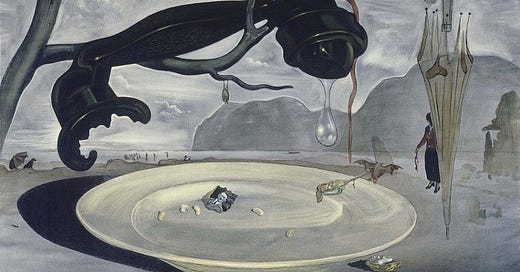Salvador Dali’s Obsession with Nazism and Fascism
Edition #27 - From ‘masturbating Hitler’ to ‘cannibalistic couple’
Hello friends,
Thank you for subscribing and supporting my newsletter. Both free and paid subscriptions are available. The best way to support my work is through a paid subscription.
Salvador Dali’s Obsession with Nazism and Fascism
Salvador Dali is inarguably one of the most renowned surrealist painters of the 20th century. Famous for his precise draftsmanship and bizarre images, his artistic repertoire included painting, sculpture, photography, and collaboration with other artists.
While we cannot dismiss the value of Dali’s art, it’s equally important to embrace Dali’s complex mindset.
Dali was allegedly an admirer of Hitler. Later, when the Spanish dictator, Francisco Franco, ruled Spain, despite his cruelty towards the commoner, Dali maintained friendly relations with him. Dali constantly affirmed his apolitical stance, but his paintings and actions did not match his statements.
George Orwell wrote an essay on him and ruminated on a question and called Dali “a disgusting human being” and an artist of “undeniably exceptional gifts.”
This article will cover Dali’s obsession with Hitler, his paintings that support Hitlerian fascism, and his camaraderie with the fascist ruler, Francisco Franco.
Dali’s fascination with Hitler
In 1934, Dali was expelled by a group of surrealist painters for his pro-Hitler views that glorified fascism. André Breton, the leader of the surrealist group, put him on trial and wrote a letter accusing him of —
Anti-humanitarians’ acts were entirely against the surrealist manifesto.
Dali’s rejection of modern art and supporting academic paintings. Being an unconventional painter, he helped Hitler’s bizarre views on contemporary art.
Dali’s fascination with Hitler and what he supposedly said to André Parinaud about his homoerotic fantasy —
I often dreamed of Hitler as a woman. His flesh, which I had imagined whiter than white, ravished me… There was no reason for me to stop telling one and all that to me Hitler embodied the perfect image of the great masochist who would unleash a world war solely for the pleasure of losing and burying himself beneath the rubble of an empire; the gratuitous action par excellence that should indeed have warranted the admiration of the Surrealists.
In response to this letter, Dali defended —
For his anti-humanitarianism, he blamed sexual perversion.
For his rejection of modern art, he gave an excuse for rejecting modern art pieces, excluding surrealism and cubism.
And finally, of his admiration for Hitler, he accepted his fantasy for him but told that his own paintings would not be accepted in Nazi Germany.
Dali’s strange attraction toward Hitler was so well-known that even the FBI suspected that he was a Nazi sympathizer.
Dali’s paintings support Hitlerian fascism

The Enigma of Hitler is a 1938 painting by Dali produced around the time when he was expelled from the surrealist movement.
The image of the melting telephone over Führer’s picture lying on a plate and an umbrella that could easily belong to the prime minister Neville Chamberlain hangs in the ether.
Although this painting does not reflect the pro-Nazi views of Dali, surrealists believed, painting Hitler when his antisemitism and barbarity were at their peak, they didn’t think it was a good idea.
The Weaning of Furniture Nutrition became another controversial art piece of Dali. A Nazi nurse wearing a swastika armband knitting while seated in a puddle of water. The surrealists were so displeased by this art piece that they asked Dali to paint out the Nazi armband.
Dali once wrote that Hitler “turned me on.”. Anything is possible in Dali’s dreams. Hitler Masturbating is a watercolor painting and depicts exactly what the title says. The Führer, in full Nazi uniform, sits on an armchair and masturbates to the view of the barren snowscape. The painting is seen to humanize Hitler by depicting him in a private yet ubiquitous act.
Dali’s camaraderie with the fascist ruler, Francisco Franco

After the Spanish Civil War outbreak in 1936, a political coup occurred, and Franco’s army invaded the Spanish Republic.
In the art world, Picasso depicted the violent bombing in the city of Guernica through his painting Guernica. While on the other side, Dali painted Autumnal Cannibalism and reemphasized his apolitical and neutral stance.
This painting depicts a couple locked in a cannibalistic embrace. They are pictured on a table-top, which merges into the earthy tones of a Spanish landscape in the background. The conflict between countrymen is symbolized by the apple balanced on the head of the male figure, which refers to the legend of William Tell, in which a father is forced to shoot at his son.
While all the Spanish painters supported Guernica in the Paris world fair and revealed the Republican struggle against fascism, Dali was missing from the event.
In 1975, when General Franco executed many people, hundreds and thousands of fascists gathered in support of Franco, chanting his name and making fascists salutes. When the world condemned this appalling act, Dali praised Franco and made him the “greatest hero of Spain.”
Last thoughts
George Orwell, a strong critic of the fascist rule in Spain, despised Dali and wrote —
“During the Spanish Civil War, he astutely avoids taking sides and makes a trip to Italy. He feels himself more and more drawn towards the aristocracy, frequents smart salons, finds himself wealthy patrons, and is photographed with the plump Vicomte de Noailles, whom he describes as his ‘Maecenas.’”
Salvador Dali was nicknamed ávida dollars (“eager for dollars”) by his former surrealist friends for selling his consciousness and idealism for money and fame.
As for himself, he was simultaneously an anarchist and a monarchist. He was knowingly and deliberately contradictory in his public expressions, aiming to shock as much as anything else.
If you enjoy my articles, I released my free e(book) Beyond Beautiful - 25 Paintings You Should Not Miss. Pick your copy now.




